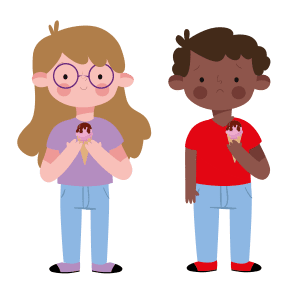One day you might be faced with the question “but what is autism?” when talking to a child.
Explaining autism to children can feel complicated since it’s quite a big subject. It doesn’t have to be.
Some children may be happy with a simple explanation. Others may want to ask lots of questions. Either way, there are five steps you can take to explain autism to a child.
Start simple
This may seem obvious, but don’t go into too much detail at first. You may be tempted to explain different things like stimming, sensory overload or meltdowns.
After all, they all form a part of the conversations around autism. But giving too much information at once can be confusing to a child depending on their age and ability.
It’s best to start off with the basics, and then build on that if the child is interested.

You could say something like:
“Autism is something you are born with. It’s not a disease or illness, and you can’t catch it. It means that someone’s brain works differently.
“It’s not a bad thing or a good thing, it’s just a difference. Just like some people have blue eyes and others have brown eyes.”
You can add to this if your child is interested, or you can slowly give them more information as teaching moments happen.
Let them ask questions
Letting your child ask questions helps them understand autism better, but also shows them it’s not a negative subject.

Sometimes people discourage conversations about autism because they’re worried about saying something wrong or feel awkward about the subject.
This can send a message that autism is something you’re not supposed to talk about, even if the person means well.
Don’t worry if you don’t have all the answers, saying you’re not sure and finding out together is a great way to show that it’s okay to not know something and explain how to find the answers.
If your child doesn’t have any questions, let them know they can still ask any questions later if they think of something.
That way you can help them feel comfortable talking about autism at any time.
Show examples
Some children may prefer to learn in different ways. You can read books and watch shows together which explain autism.
This can also help if you need some guidance answering questions. It can be a good idea to include books and shows about differences, like autism or disability, into your child’s usual routine.

This will help normalise those subjects and help them learn about different conditions.
Try to find something that’s relevant to your child. For example, books about autistic children in a school setting if the child is learning about what autism is because they have an autistic classmate.
That way your child may find it easier to apply their learning in their day-to-day life.
Be positive
Talking about autism doesn’t need to be a negative topic.
It’s true that being autistic can be difficult because of lack of awareness, accessibility or support.
But while it’s important to talk about the barriers autistic people face, it’s also important to explain that autistic people can lead happy, independent, and fulfilling lives.
Talking about this can be a great opportunity to explain why it’s important to be kind, inclusive and considerate.
Autistic people have many strengths and talents. They go to school, have jobs, have children, travel, and much more.
Your child may wonder why some autistic people can do something while others can’t. You might want to say something like: “Every autistic person has different needs. Some people might need more help than others. Every autistic person is unique, just like everybody else.”
Teach compassion
Children may not understand why someone is acting differently. They might think an autistic person is being ‘naughty’ or ‘weird’ when they don’t behave in a way the child would expect.
They may even feel confused or upset by seeing a new and different behaviour.

It’s important to acknowledge what the child is feeling, and then explain and discuss the situation.
For example, if your child says an autistic person is ‘naughty’ you can say something like:
“Amy is screaming loudly and flapping her hands because she is very excited. Usually when a friend does something like this it can look naughty or distracting. So I understand why you would think that.
“But different people handle their emotions in different ways. Some people are very quiet and others may need to do something to get those feelings out, even because of something small, and that’s okay.”
Encourage them to speak to you if they’re unsure when seeing a different behaviour. That way they are less likely to learn untrue information about things like autism.
For more information and to check out all of the support we offer visit our services page.
If you liked this post, check out our Facebook, Twitter and Instagram where we share similar content.
)

)
)
)
)
